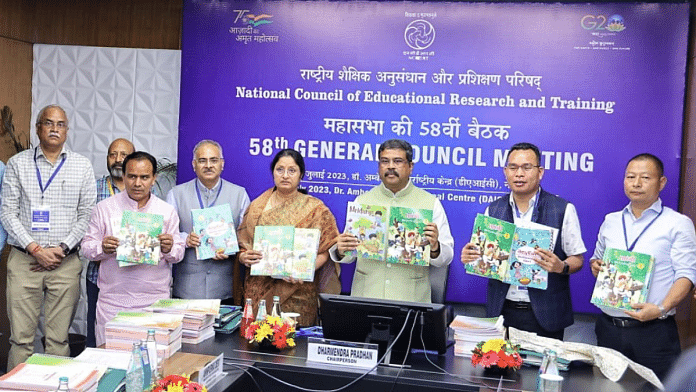New Delhi: Popular Hindi rhymes and liberal use of regional words feature in the NCERT’s new textbooks for Class 1 and 2 in line with the recommendations of the National Education Policy (NEP).
Schoolchildren will now read Hindi from the textbook, Sarangi, which was previously named Rimjhim. Instead of two English textbooks Marigold and Raindrop, there is now only one — Mridang.
Similarly, Maths textbooks have been renamed Anandamaya Ganitat and Joyful Mathematics to reflect the inclusion of Indian culture in the education system.
Education Minister Dharmendra Pradhan had released the textbooks Tuesday at the council meeting of the National Council of Educational Research and Training.
Rhymes like ‘Chanda mama door ke’, ‘Murga bole kukdu ku’, and ‘Chale mere ghode ki chaal’ are among the new additions to the Hindi textbook.
Children in the stories and poems greet each other with ‘namaste’, ‘shubh ratri’ and ‘suprabhat’ in the textbooks.
“Indian values and traditions have been presented to the learner in an easily comprehensible and acceptable way. This has been achieved through aptly placed illustrations, Indian ways of greetings like ‘Namaste’ in ‘Greetings’, exposure to a variety of Indian foods from across the country in the lesson ‘Eating Together’, exposure to a variety of fruits and vegetables found in India in the lesson ‘A Visit to the Market’, and so on,” reads the ‘About the book” section of Class 1 textbook for English.
Slight touches have been given to existing contents as well. For instance, the English poem ‘Old McDonald had a farm’ is now ‘My dear grandpa had a farm’.
A chapter titled ‘We are Indians’ has been added to Class 2 English textbook which has children and families from different parts of the country talking about their festivals and cultures with texts like:
I am Badal.
I come from Bengal.
I speak Bengali.
I like painting and music. I study at Santiniketan.
To add diversity to children’s textbooks, a story of a girl called Onshangla from the Northeast has been added. This is different from the content of the previous textbooks — Raindrop and Marigold — which had poems and stories on rain, animals and human body without the Indian context.
“In addressing the first eight years of a child’s life, this holistic approach — which includes the cultivation of sanskar which are passed on from generation to generation — has a critical and positive lifelong influence on every aspect of a child’s growth, health, behaviour, and cognitive capabilities in the later years,” NCERT director Bharat Sakhlani writes in the foreword of these textbooks.
The Hindi, English and Mathematics textbooks are tailored according to the National Curriculum Framework (NCF) approved by former ISRO chief K. Kasturirangan-led National Steering Committee.
”Play is at the core of these textbooks, which will motivate children to learn with interest and joy. These will be helpful in the holistic development of children, and ensure joyful learning at the foundational stage, as envisaged by NEP,” Education minister Dharmendra Pradhan said at the NCERT meeting.
While the NEP aims to devise a framework to bring about a paradigm shift in education, with focus on holistic development of children, learning in mother tongue and cultural rootedness, the NCF is a key component of the NEP and is intended to be a blueprint for school syllabi across the country.
Released in April, the NCF draft had observed that “one of the key curricular goals is for students to appreciate the importance of being an Indian by understanding the country’s glorious past and its rich diversity, geographical and cultural”.
(Edited by Tony Rai)



